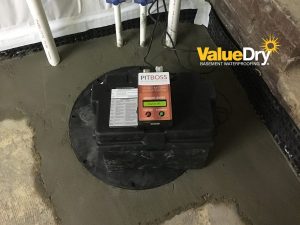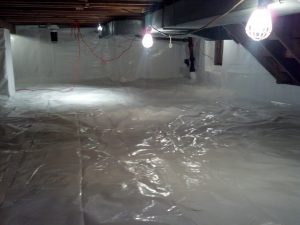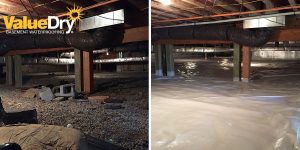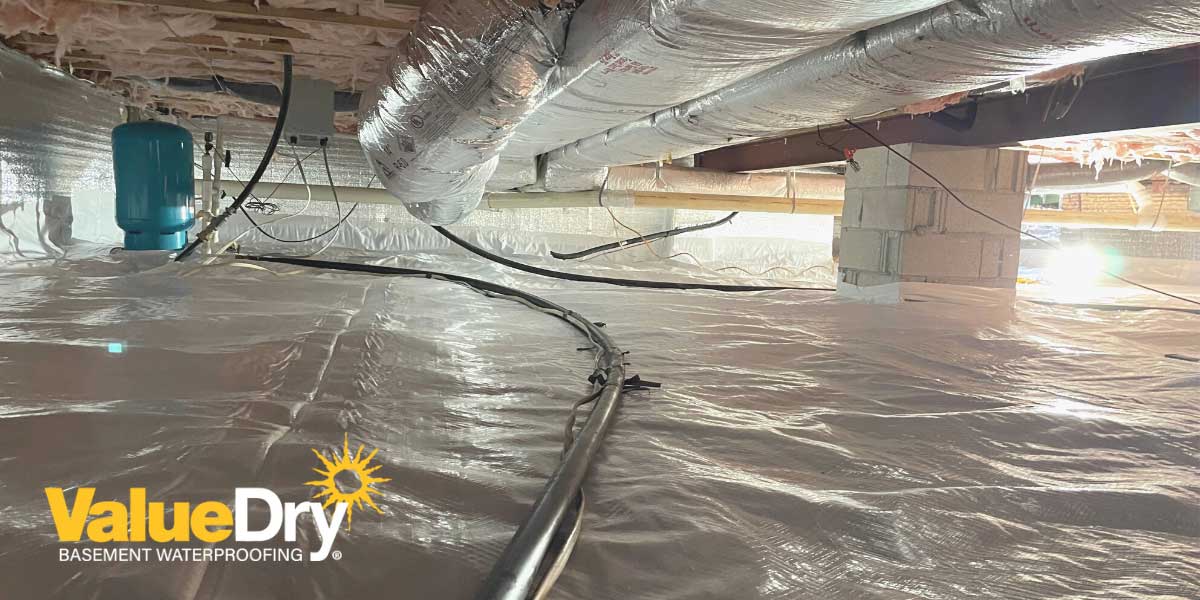Insulating Crawl Space With Dirt Floor
- February 3, 2023
- No Comments
If you do not have a basement, your home is most likely built on a crawl space, which is the space between your lowest floor and the ground. It’s not a place most homeowners often visit, so it can become an “out of sight, out of mind” sort of thing.
If you’ve noticed musty smells, indoor allergy symptoms, cold surfaces in winter, mold, and mildew growth on first-level floors, cupping and swelling flooring in the summer, or an increase in pest population upstairs in your living space, your crawl space could be to blame.
Should a crawl space with a dirt floor be insulated?
Yes! A dirt crawl space floor is just the bare earth under your home, which is a natural source of moisture. A damp or wet crawlspace is a breeding ground for mold spores, which can lead to poor indoor air quality and increased humidity levels in your home. High moisture levels can also lead to wood rot in crawl space walls and ceilings.
Without properly installed drainage, insulation, crawlspace liners being sealed off and insulated, and the utilization of a ventilation and/or dehumidification system you are inviting standing water, unwanted pests, mold growth,  unhealthy air, and more into your home.
unhealthy air, and more into your home.
The solution is to not just repair or re-insulate in between the floor joist on the crawl space ceiling but to have a company that specializes in encapsulation professionally encapsulate your crawlspace. Insulation is just part of the plan to keep the moisture, humidity, and resulting unhealthy air out of your home.
If there is standing water inside or a place where water could come in when it rains, we always recommend installing a drainage system that could include a sump pump installation, interior French drains, and more. This helps to ensure that the water has somewhere to go and doesn’t continue to contribute to increased humidity which could result in unhealthy mold growth.
What is the best way to insulate a dirt floor crawl space?
To hold back the moisture from making its way into the air in your crawl space and eventually into your home, the best way to ‘insulate’ is through a process called crawl space encapsulation. Insulation is just one part of the encapsulation process.
There are several steps and if any are missed, you could hurt your home’s air quality more than help.
- Interior Drainage: Manage any water that comes into the crawlspace with an interior drainage system, which may include a sump pump.
- Insulate the walls: This includes installing a manufacturer-rated insulated vapor barrier on the walls. You also must insulate along the perimeter band board, between the joist, and above the foundation wall.
- Floor mat installation: A mat for drainage is installed on the dirt floor and covered by a plastic water vapor barrier. The vapor barrier on the floor must be sealed to the wall insulation to help prevent moisture from entering through the dirt and walls.
- Tight Seal: It is important that all of the seams of the vapor barrier are properly sealed with a strong, waterproof, durable, and water-resistant material to create a tight seal.
- The insulation on the wall needs to be sealed to the top of the foundation using double-sided tape or adhesive to prevent additional air leaks.
- Any vents, pipes, or supports penetrating the wall or floor must be sealed to ensure a proper seal of any gaps and cracks. Once all of this is done, you have effectively created a space that is ‘encapsulated’ from the outside world.
- Conditioning: The last step of encapsulating is to condition the space. You MUST condition the space by installing a dehumidifier, ventilation device, HVAC system, or a combination to manage humidity and the general air quality in the space.
What is crawl space encapsulation?
Crawl Space Encapsulation is the process that uses waterproofing materials, plastic vapor barriers, tapes, sealants, and an HVAC system, dehumidifier, ventilation device, or combination thereof to seal and condition the crawlspace. The encapsulation process is performed with the intention of keeping water out and maintaining humidity and healthy air quality.
A properly installed crawl space encapsulation system turns a wet, dirty, and possibly unhealthy moldy space into a clean, safe area for your home’s occupants.
If you or a service person do happen to go into your crawlspace and see standing water, mold, decaying building materials, or condensation underneath your home don’t turn a blind eye! These are clear indications that you and your family need crawl space encapsulation to keep moisture and unhealthy air out of your home.
Crawl space encapsulation vs insulation
Many homeowners confuse crawl space encapsulation and crawl space insulation. Crawl space encapsulation is a system consisting of many parts intended to insulate the home from cold and hot air and to protect the home by managing unwanted foundation seepage, groundwater leaks, standing water, moisture, and humidity.
Insulation is only a small part of a professionally designed encapsulation solution. It can temporarily help with cold floors, but it doesn’t address seepage and moisture issues.
floors, but it doesn’t address seepage and moisture issues.
If the foundation seepage and moisture content issues are not addressed, you are throwing away money by just insulating.
Oftentimes professional crawl space encapsulation companies, like Value Dry Waterproofing, can properly encapsulate a dry crawlspace with a permanent warrantied solution for a similar cost to removing and replacing fallen, damaged “in between the joist” fiberglass insulation.
Insulating a crawlspace should only be offered as part of the encapsulation system. The proper combination ensures that insulation materials won’t end up wet, moldy, and hanging down on a dirty damp floor, creating unhealthy air which is a danger to your family.
An added benefit to encapsulating vs just insulating a crawl space is increased HVAC efficiency and lower energy bills. If your HVAC system is not working to keep a floor warm in the winter or cold in the summer, it will cost you less money to run!
Should you insulate or encapsulate?
BOTH! Don’t waste your money with a temporary, insulation-only solution! Create a healthy and efficient environment for your home by having a professionally designed and installed crawl space encapsulation system installed that includes expertly installed insulation!
If done properly, the correct way to remove moisture buildup from dirt floor crawl spaces is to insulate AND encapsulate. You need to do BOTH along with installing the necessary drainage and a ventilation or humidity management system.
encapsulate. You need to do BOTH along with installing the necessary drainage and a ventilation or humidity management system.
If you just insulate, you don’t have a healthy encapsulated crawl space, you just have insulated floors. The insulation will eventually fail, falling to a dirty floor and potentially creating air quality issues in your crawl space and upstairs in your home.
We can’t even count the times that insulation was placed between the floor joist of a crawl space only to end up falling down on the dirt floor during the first hot humid summer day needing to be thrown away and replaced again and again.
Proper crawlspace insulation is only part of the encapsulation solution. We always recommend insulation done the right way, as part of the solution.
What are the signs that I need Encapsulation?
Here is the best way to evaluate your crawlspace:
Open up your crawl space access and shine a flashlight in there. Ask yourself these questions:
- Do you see any standing water?
- Is there any visible mold growth?
- Any fallen insulation?
- Can you see outside sunlight through open vents or cracks?
- Any evidence of standing water?
- Is a musty smell immediately apparent?
If you can answer yes to any of these questions, contact a crawl space expert today! All are clear signs that you would benefit from professional crawlspace encapsulation.
Professional Crawl Space Insulation
To protect your home, be energy efficient, and improve air quality, it is vital to hire a professional crawl space encapsulation company. You can be assured that proper insulation and encapsulation methods will be implemented to keep your crawl space dry.
Handymen or insulation-only companies will insulate for crawlspaces, but they will NOT take the required steps to encapsulate, AND condition (ventilate or dehumidify) and manage the humidity within.
This may provide a temporary solution for moisture, but it does not prevent unhealthy air from entering upwards into the living spaces of your home. In fact, they are creating a situation that propagates unhealthy environments and an inefficient home.
Don’t just insulate! Encapsulate!
If you’re looking to install insulation for crawl spaces as part of an encapsulation system, make sure it’s done professionally, ensuring that proper measures are taken to protect your home and family. Call Value Dry Waterproofing today to schedule an estimate.
We work with homeowners throughout Maryland, Northern Virginia, the Eastern Panhandle of West Virginia, the District of Columbia as well as parts of Delaware. We also offer annual Value Dry Protect, preventative maintenance, and crawl space inspections to all our customers to ensure our systems are functioning properly year after year, keeping your family safe!


